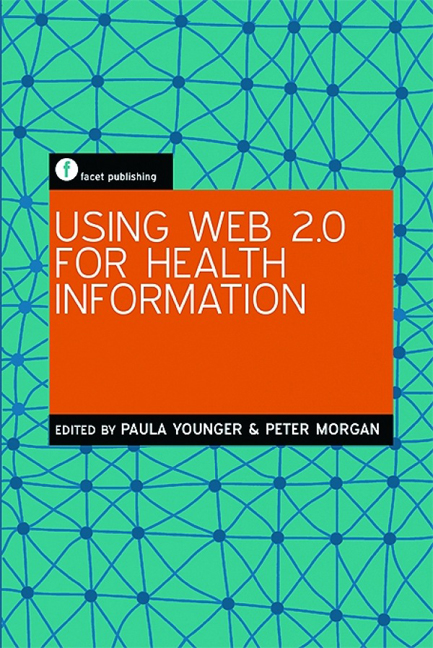Book contents
- Frontmatter
- Contents
- Preface
- Acknowledgements
- Contributors
- Glossary
- Introduction
- Part 1 The basics
- 1 Health information: an overview
- 2 Web 2.0 in healthcare information: an overview
- Part 2 Web 2.0 and the implications for health information
- Part 3 Web applications in health information provision: some practical examples
- Part 4 The future
- Index
1 - Health information: an overview
from Part 1 - The basics
Published online by Cambridge University Press: 08 June 2018
- Frontmatter
- Contents
- Preface
- Acknowledgements
- Contributors
- Glossary
- Introduction
- Part 1 The basics
- 1 Health information: an overview
- 2 Web 2.0 in healthcare information: an overview
- Part 2 Web 2.0 and the implications for health information
- Part 3 Web applications in health information provision: some practical examples
- Part 4 The future
- Index
Summary
What is health information?
Healthcare and medical information professionals have always been quick to adopt new technology (Kumar and Rawat, 2010; McKnight, 2005). This is, in part, due to the nature of their users: healthcare professionals require their information to be as up to date and accurate as possible. The consequences of not having such information to hand are laid out starkly by HIFA2015:
Every day, tens of thousands of children, women and men die needlessly for want of simple, low-cost interventions – interventions that are often already locally available. A major contributing factor is that the mother, family caregiver or health worker does not have access to the information and knowledge they need, when they need it, to make appropriate decisions and save lives. (HIFA2015, c2010)
Lack of access to information remains a major barrier to knowledge-based healthcare in developing countries. The development of reliable, relevant, usable information can be represented as a system that requires co-operation among a wide range of professionals, including healthcare providers, policy makers, researchers, publishers, information professionals, indexers and systematic reviewers (Godlee et al., 2004).
Before we look in more detail at the potential for Web 2.0 to influence healthcare and medical information, it is pertinent to establish just what is meant by health information.
Broadly, health information consumers divide into two groups: those who deliver care, and those who receive it. Healthcare deliverers divide into two further broad groups: those who have direct contact with patients and those who make a difference to patient care indirectly. Medics, nurses and patient information professionals fall into the first group; librarians, managers, information professionals (including researchers) and health informatics professionals fall into the second group, in the majority of cases.
The direct deliverers subdivide into many further groups: qualified physicians and nurses, medical and nursing students, and allied health professionals are just some. Each group requires a different type of information: the qualified medics and nurses may require information to enable them to treat a patient, to enhance their own continuing professional development or to prepare a presentation, ward meeting, training session or board paper. Students, on the other hand, may simply require a brief overview of a condition or intervention in order to pass an assignment and build a foundation for their further career development.
- Type
- Chapter
- Information
- Using Web 2.0 for Health Information , pp. 3 - 8Publisher: FacetPrint publication year: 2011



